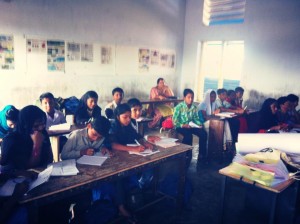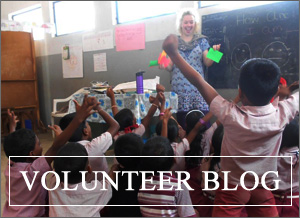Our fourth instalment from Becky’s ‘India: A Volunteers Guide From Start To Finish’ is about Becky’s time in school, from teaching classes of forty students and what to do when things don’t go as planned! If you’ve missed Becky’s other blogs, make sure you take a look at them here!
There is no denying that teaching is hard work with the heat and language barrier, but it’s definitely worth it if you put the effort in. The main thing is to keep everything simple. You’re role as a volunteer is to get the children practicing spoken English as much as possible, so plenty of songs and games is a must.
I taught four classes, alongside another volunteer. Team teaching was very effective for us because we both brought new ideas forward, and also in bigger classes we were able to split them into groups. If you end up team teaching, try to make the most of the advantage it gives you, but if you struggle with this you can always ask to be separated. The classes we taught all had different levels of English, but we used the same basic lesson plan for each class with slight alterations.
For example, for the younger class it took much longer to complete tasks, so we always focused on one main task and repeated it throughout the lesson. The brightest class sometimes completed everything before the end of the lesson, so we usually did a fun recap using games, or had ‘story time’, where we all sat in a circle on the floor and took turns telling different lines of a story.
The school we taught at was much smaller than the average Indian school, we were lucky to only have around forty children in our class. It’s very hard to learn all the students’ names, I wouldn’t actually recommend wasting too much time trying to learn them. However, if you have any students who are persistently disruptive or persistently very well behaved, it’s essential you learn their names so you can pin point them in the lesson, rather than shouting at/praising the whole class. This way, the other students will see that the good student gets positive recognition and want to follow their example, vice versa with the disruptive student.
We didn’t like to send students out of the classroom in case they were caned, so if it got to that point, we would instead stand them in the corner of the room facing away from everybody else. I actually think this was more effective, because they could see the lesson and always got jealous that they couldn’t join in games and get stickers and rewards like the other students.
Depending on the school you are teaching in, you will have different resources. In our school we had a library that we were allowed to take the children down too. You should make full use of the different resources and space you have in your school because the change of scenery for the children always made them really eager and lively for the lesson, and they learn a lot more. This is especially good if you are doing a particularly lively lesson like learning a song with dance moves.
There will be a lot that doesn’t work when you are teaching, but don’t let that discourage you, just remember you are in a different country and it is not a personal fault on your behalf. If the lesson you planned just doesn’t work, laugh about it, shake it off and try something else!





Comments are closed.